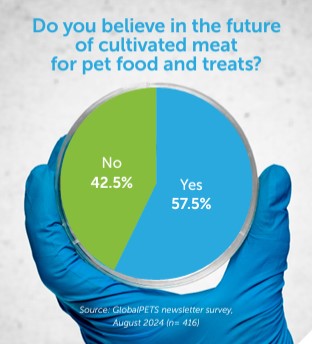The era of cultivated meat pet food gets a step closer

Recent advances worldwide have put lab-grown meat on an accelerated pathway to market for use in pet food – but there are still challenges to be addressed.
A single week in mid-July encapsulated the startling pace of regulatory progress made by the cultivated pet food sector, with several companies around the world making exciting announcements. However, industry insiders still exercise caution about how cultivated meat and other ingredients will affect the sector.
A first for the UK
In a few months’ time, people in the UK will be able to buy meat for their dogs made from cultivated chicken cells.
This is thanks to Meatly, a London-based start-up that became the first company to receive approval for cultivated meat in Europe, after the UK’s Food Standards Agency (FSA) gave the go-ahead in early July.
A fast-developing story
Meatly’s announcement came during an extraordinary week for cultivated pet food.
One day later, California’s Friends & Family Pet Food Company partnered with Singaporean cultivated seafood company Umami Bioworks to make cat treats.
And the next day, Further Foods – a subsidiary of Canadian cellular agriculture investor CULT Food Science – said it planned to begin dog feeding trials in its hunt for regulatory approval for cultivated chicken under the Noochies! brand.
The approval for Meatly was the result of an 18-monthlong process, featuring assessments and site visits from the FSA, the Department for Environment, Food and Rural Affairs (DEFRA) and the Animal and Plant Health Agency (APHA).
To get to this point, the start-up registered as a feed business operator, while conducting extensive testing to prepare a comprehensive dossier proving that cultivated chicken is safe and healthy for pets, and contains no antibiotics, harmful pathogens, heavy metals or GMOs.
Cutting costs to market
Now, Meatly – whose chicken is suitable for both dogs and cats – is ramping up production to supply pet food manufacturers, who will combine its cultivated meat with plant-based ingredients.
The company has lowered the cost of its culture media – a nutrient mix that promotes the growth of animal cells – from hundreds of pounds to just £1 (€1.19/$1.32) per liter.
This is a major breakthrough, since this accounts for the main cost of cultivated meat. Even so, just as most meat-based pet food also contains other ingredients, the cost of producing it is still too prohibitive for the end product to be made of 100% cultivated meat.
Austrian-American start-up BioCraft Pet Nutrition, which is making cultivated mouse meat, similarly cut the price of its growth media, with the end product now priced at between $2 (€1.80). and $2.50 (€2.25). The Noochies! products will be priced on a par with conventional premium dog treats (freeze-dried or raw).
Accelerated path
These advances will likely accelerate cultivated pet food’s route to market, which is already quicker than the path for human-focused start-ups, according to international non-profit and think tank the Good Food Institute (GFI) Europe. They will also breed new players, like Friends & Family.
Its CEO Joshua Errett says he started the company after identifying two trends: “One, cultivated meat companies need to get to market. And two, there were no [consumer-facing] cultivated meat pet brands.”
“I’m building an innovation studio for cultivated meats, creating product lines to showcase a variety of cultivated ingredients. Right now, that’s a very unique model. But I think very soon it will be the standard and you’ll see lots of other cultivated brands following this idea,” he adds.
Is it safe and healthy?
Errett is also a former VP at CULT Food Science, which had acquired his brand Noochies!.
In August, the company submitted its trial design to the US Food and Drug Administration (FDA). This is part of an approval process that also regulates feed ingredients and is overseen by the FDA’s Center for Veterinary Medicine (CVM).
“Since these are new ingredients or ingredients being produced using new methods, the FDA wants to know that they perform the same as conventionally produced meat. In other words, is it safe and healthy to feed animals products containing cultivated meat?” explains Mitchell Scott, CEO of CULT Food Science.
Preparing for launch
The CVM works with the Association of American Feed Control Officials (AAFCO), an independent non-profit that sets standards for novel pet ingredients.
Once the FDA approves the trial protocol (within 45 days), Further Foods will begin tests on 30 healthy, adult dogs for 26 weeks.
“My understanding is that we submit the results of the feeding trials, and then there may be some further back and forth before we are approved to sell,” reveals Scott.
The aim is to launch cultivated treats under the Noochies! brand in early 2025. Meanwhile, Friends & Family is also gunning for regulatory approval in the US and targeting 2025 for an initial limited launch.
Beware of boom and bust
Errett calls Meatly’s approval a “huge step”, but when it comes to how it will affect the sector at large, he exercises caution. “There’s lots of ebb and flow in the industry,” he says. Having also co-founded BioCraft Pet Nutrition, he has been in the cultivated pet food space since 2016.
“My company at the time was the first and only company in the world doing cultivated meat pet food. I’ve seen boom-and-bust cycles in that short time, lots of players vying to be first-movers, lots of investment, and then lots of companies and investors pulling out of the space too,” he explains.
Regulatory approval is just the first step
“The same is true now as it was then: the sector will only succeed if you have people who genuinely care about companion animals, who are committed to the pet food category and who are willing to do the steps to make it viable in the long term. So regulatory approval is a great step, but it’s the first of many to come,” he cautions.
Scott thinks Meatly’s greenlight is positive either way.
“It means that people are paying attention to the industry and that some players out there feel threatened by it. The more awareness we can bring – even if it’s polarizing – to this new method of food production, the better,” he says.
Political obstacles
Two challenges loom large: politics and money.
Italy has banned cultivated meat, as have the US states of Florida and Alabama. A spate of other states and EU countries, including Hungary, are mulling similar measures.
A recent GFI Europe survey of over 16,000 Europeans found that over half of respondents in 13 nations supported the approval of cultivated meat, if regulators find it safe and nutritious.
“A majority of respondents agreed with this approach in Italy and Hungary, despite their governments moving to ban cultivated meat,” says Seth Roberts, Senior Policy Manager at the think tank. “This suggests many people are more interested in consumer choice than in ideological debates.”
Investment tide turning
Meanwhile, investors have seemed to be deserting the entire food tech sector in the last couple of years and cultivated meat is no exception.
According to GFI Europe research, investment in cultivated meat dipped by 75% in 2023. But the declining tide may be stemmed this year; the first half of 2024 attracted 57% of the $226 million (€203M) this sector raised in all of 2023.
“Investors will look at a range of factors including regulatory pathways,” says Roberts. “So, we’re hopeful that news about Gourmey’s application to regulators [French start-up Gourmey has become the first company to apply for EU market access for cultivated meat] – as well as Meatly’s approval in the UK – will lead to a renewed interest in Europe’s cultivated meat companies.”
Demonstrating demand
For cultivated pet food companies, driving investment is all about “demand, demand, demand”, according to Errett.
“That’s why we need to get a physical product in front of customers, to show demand. It’s like any other business – you need to make sure it’s a viable product in the market before you make huge investments like building factories or even scaling up the inventory,” he states. “I think it’s difficult to justify huge investments into a product when you don’t have a single customer.”

